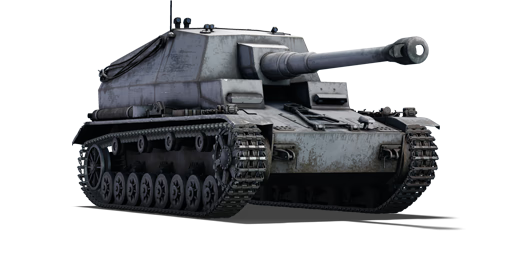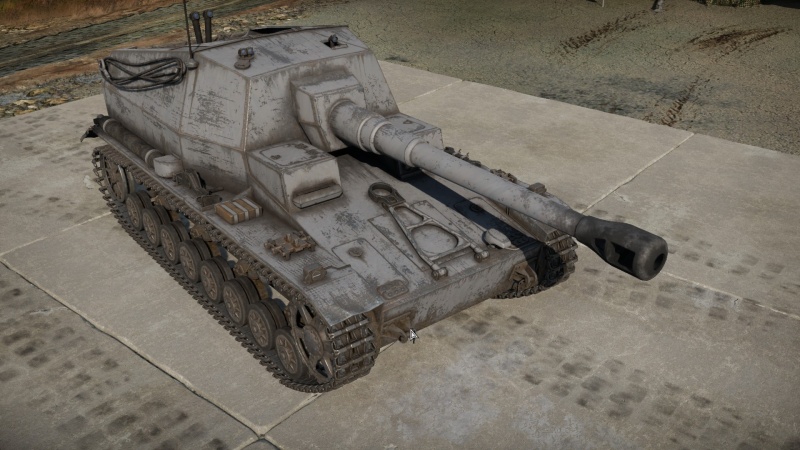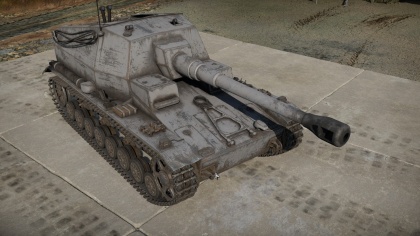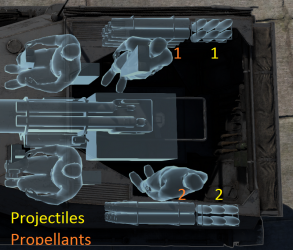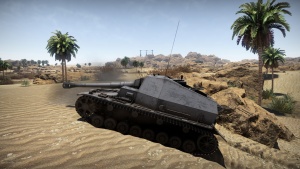Difference between revisions of "Dicker Max"
Colok76286 (talk | contribs) (→Media: Added video) |
|||
| Line 1: | Line 1: | ||
| − | {{Specs-Card|code=germ_pzsfl_IVa_dickermax}} | + | {{Specs-Card |
| + | |code=germ_pzsfl_IVa_dickermax | ||
| + | |images={{Specs-Card-Image|GarageImage_{{PAGENAME}}.jpg}} | ||
| + | }} | ||
== Description == | == Description == | ||
| Line 11: | Line 14: | ||
== General info == | == General info == | ||
=== Survivability and armour === | === Survivability and armour === | ||
| + | {{Specs-Tank-Armour}} | ||
<!--''Describe armour protection. Note the most well protected and key weak areas. Appreciate the layout of modules as well as the number and location of crew members. Is the level of armour protection sufficient, is the placement of modules helpful for survival in combat?'' | <!--''Describe armour protection. Note the most well protected and key weak areas. Appreciate the layout of modules as well as the number and location of crew members. Is the level of armour protection sufficient, is the placement of modules helpful for survival in combat?'' | ||
| Line 33: | Line 37: | ||
=== Mobility === | === Mobility === | ||
| + | {{Specs-Tank-Mobility}} | ||
<!-- ''Write about the mobility of the ground vehicle. Estimate the specific power and manoeuvrability, as well as the maximum speed forwards and backwards.'' --> | <!-- ''Write about the mobility of the ground vehicle. Estimate the specific power and manoeuvrability, as well as the maximum speed forwards and backwards.'' --> | ||
{{tankMobility|abMinHp= 256|rbMinHp= 159|<!--AoAweight=(optional) -->}} | {{tankMobility|abMinHp= 256|rbMinHp= 159|<!--AoAweight=(optional) -->}} | ||
| + | |||
| + | === Modifications and economy === | ||
| + | {{Specs-Economy}} | ||
== Armaments == | == Armaments == | ||
| + | {{Specs-Tank-Armaments}} | ||
=== Main armament === | === Main armament === | ||
| + | {{Specs-Tank-Weapon|1}} | ||
<!--''Give the reader information about the characteristics of the main gun. Assess its effectiveness in a battle based on the reloading speed, ballistics and the power of shells. Do not forget about the flexibility of the fire, that is how quickly the cannon can be aimed at the target, open fire on it and aim at another enemy. Add a link to the main article on the gun: <code><nowiki>{{main|Name of the weapon}}</nowiki></code>. Describe in general terms the ammunition available for the main gun. Give advice on how to use them and how to fill the ammunition storage.''--> | <!--''Give the reader information about the characteristics of the main gun. Assess its effectiveness in a battle based on the reloading speed, ballistics and the power of shells. Do not forget about the flexibility of the fire, that is how quickly the cannon can be aimed at the target, open fire on it and aim at another enemy. Add a link to the main article on the gun: <code><nowiki>{{main|Name of the weapon}}</nowiki></code>. Describe in general terms the ammunition available for the main gun. Give advice on how to use them and how to fill the ammunition storage.''--> | ||
{{main|K.18 (105 mm)}} | {{main|K.18 (105 mm)}} | ||
Revision as of 09:26, 28 December 2020
Contents
Description
The 10.5cm K18 Pz.Sfl.IVa "Dicker Max" is a rank II German tank destroyer
with a battle rating of 4.0 (AB) and 3.7 (RB/SB). It was introduced in Update 1.57 "Battle March".
The Dicker Max is a open-topped SPG with a 105 mm (10.5 cm), based on the Pz.IV E chassis. The 10.5 cm artillery gun is not only more effective than the StuH's 10.5 cm howitzer, but it is very consistent in terms of the results: hits that usually devastate the enemy. Its 14 second reload is not bad either, for a gun of its size, 4 seconds faster than the StuH, and over twice as fast as the KV-2's. The 105 mm HE round can also be effective on many lightly armoured vehicles like the M18 Hellcat.
General info
Survivability and armour
Armour type:
- Rolled homogeneous armour
| Armour | Front (Slope angle) | Sides (Slope angle) | Rear (Slope angle) | Roof |
|---|---|---|---|---|
| Hull | 12 mm (77°) Front glacis 50 mm (20°) Lower glacis 50 mm (14°) Driver ports |
20 mm | 20 mm (9°) | 12 mm |
| Superstructure | 30 mm (14°) Front 50 mm (16°) Gun mantlet |
20 mm (21°) | 20 mm (9-17°) | 10 mm |
Notes:
- Suspension wheels are 15 mm thick and tracks are 20 mm thick.
- The roof of the superstructure does not fully cover the top, thus still exposing the crew members.
Mobility
| Game Mode | Max Speed (km/h) | Weight (tons) | Engine power (horsepower) | Power-to-weight ratio (hp/ton) | |||
|---|---|---|---|---|---|---|---|
| Forward | Reverse | Stock | Upgraded | Stock | Upgraded | ||
| Arcade | 31 | 6 | 21 | 256 | 343 | 12.19 | 16.33 |
| Realistic | 28 | 6 | 159 | 180 | 7.57 | 8.57 | |
Modifications and economy
Armaments
Main armament
| 105 mm K.18 | |||||
|---|---|---|---|---|---|
| Capacity | Vertical guidance |
Horizontal guidance |
Stabilizer | ||
| 26 | -15°/+10° | ±8° | N/A | ||
| Turret rotation speed (°/s) | |||||
| Mode | Stock | Upgraded | Prior + Full crew | Prior + Expert qualif. | Prior + Ace qualif. |
| Arcade | 7.1 | 9.9 | 17.8 | 19.6 | 20.9 |
| Realistic | 7.1 | 8.4 | 10.2 | 11.3 | 12.0 |
| Reloading rate (seconds) | |||||
| Stock | Prior + Full crew | Prior + Expert qualif. | Prior + Ace qualif. | ||
| 16.9 | 14.9 | 13.8 | 13.0 | ||
Ammunition
| Penetration statistics | |||||||
|---|---|---|---|---|---|---|---|
| Ammunition | Type of warhead |
Penetration in mm @ 0° Angle of Attack | |||||
| 10m | 100m | 500m | 1000m | 1500m | 2000m | ||
| PzGr | APHE | 155 | 153 | 144 | 133 | 123 | 114 |
| Gr.19 | HE | 23 | 23 | 23 | 23 | 23 | 23 |
| Pzgr.rot | APCBC | 187 | 184 | 174 | 162 | 151 | 141 |
| Shell details | ||||||||||
|---|---|---|---|---|---|---|---|---|---|---|
| Ammunition | Type of warhead |
Velocity in m/s |
Projectile Mass in kg |
Fuze delay
in m: |
Fuze sensitivity
in mm: |
Explosive Mass in g (TNT equivalent): |
Normalization At 30° from horizontal: |
Ricochet: | ||
| 0% | 50% | 100% | ||||||||
| PzGr | APHE | 822 | 14 | 1.2 | 19 | 238 | -1° | 47° | 60° | 65° |
| Gr.19 | HE | 835 | 15.1 | 0.1 | 0.5 | 1,850 | +0° | 79° | 80° | 81° |
| Pzgr.rot | APCBC | 822 | 15.56 | 1.2 | 19 | 357.5 | +4° | 48° | 63° | 71° |
Ammo racks
| Full ammo |
Ammo Part |
1st rack empty |
2nd rack empty |
Visual discrepancy |
|---|---|---|---|---|
| 26 | Projectiles Propellants |
14 (+12) 14 (+12) |
1 (+25) 1 (+25) |
Yes |
Usage in battles
As with any open-topped SPGs (such as the Marder IIIs), this is not a vehicle to charge the opponent with. However, one that can very effective at long ranges and from behind cover. An alternative play style for these vehicle in a closer range is supporting standard tanks by watching their flanks. It is NOT a fast vehicle, especially in realistic and simulator battles, but once it finds a place to stop and take aim, its gun is a very, very efficient anti-tank weapon, comparable to that of the mighty KV-2 turreted assault gun. Its most notable feature is its extreme gun depression, over -15° to +10°, which allows this tank to take advantage of great hull-down positions behind hills, becoming near-invisible in RB and SB at distance. Its weakness however, is rather obvious: the crew compartment is thinly armoured, which means basically anything can penetrate it can cause havoc for the tank commander and his crew. Combined with its slow acceleration, this is a vehicle to be used in a tactical manner in both offensive or usually, defensive combat.
With only 50 mm of armour at a battle rating of 4.3, the Dicker Max can be defeated frontally by any vehicle of its rank, even at some range. It is particularly vulnerable to SPAAs with a high rate of fire (heavy machine guns can penetrate the rear, or shoot down into the cabin should the opportunity present itself) and large-caliber shells. Airplanes are also devastating, especially if they are full of guns. Artillery is also worth noting.
Modules
| Tier | Mobility | Protection | Firepower | ||
|---|---|---|---|---|---|
| I | Tracks | Parts | Horizontal Drive | ||
| II | Suspension | Brake System | FPE | Adjustment of fire | Pzgr.rot |
| III | Filters | Crew Replenishment | Elevation Mechanism | ||
| IV | Transmission | Engine | |||
Pros and cons
Pros:
- 105 mm shells have excellent armour penetration.
- Gun is very accurate, even when stock.
- Somewhat fast reload for its caliber.
- Excellent post penetration damage.
- 5 crew member.
- Nigh invincible from the front when hulled down behind a hill.
- Absurdly excellent gun depression.
- The Pzgr.rot shell is a huge boost to it's already lethal gun, with penetration comparable to the 122mm guns of the IS-2.
- Somewhat low profile.
- Very good in maps with lots of open grounds.
- Has no trouble when getting uptiered with the Pzgr.rot equipped.
- With the Pzgr.rot shells equipped, it can reliably penetrate the Panther's upper glacier, a feat that few guns in its rank could do.
- Introduced a new play style in the German TD tech tree that can be employed with great effectiveness with later vehicles on the tree.
Cons:
- Stock shells are inadequate when getting uptiered.
- With thin armour and a open top, Dicker Max is extremely vulnerable to artillery, HE shells, heavy machine gun fire, SPAAs, and air strikes
- With a top speed of 20 mph and a slow acceleration, this SPG will not get to places very quickly.
- Bad in maps with urban environment.
- Vehicle turns at a slow rate, which is bad in any situation.
- Very slow at scaling cliffs and obstacles.
- Underwhelming performance of HE shells.
- Rear section of the fighting compartment sides are littered with ammo, shots there are often lethal.
- Reverse speed is abysmal.
- No coaxial or mounted MGs.
- Frontal hits tend to break gun
History
Development
The role of the “assault gun” in the German army in World War II gave the infantry an upper hand in assaulting fortification. However, heavy bunkers could withstand large punishment from artillery and closing up to the bunker for a closer shot exposed the assault guns and artilleries to defensive artillery weapon. A weapon was needed to fight bunkers at an extreme range that the bunkers and other defensive weaponry would not be able to return fire, something with a very heavy gun to destroy these bunkers. Krupp began development of such a vehicle in 1939, but such a vehicle soon became unnecessary with the conclusion of the Battle of France. Thus, the project shifted from a heavy “assault gun” to a tank destroyer. Two of these vehicles were built in January 1941 and were presented to Hitler in March 1941. It was hoping that if proved favorable, the vehicle would be able to be put into service and production by Spring 1942.
Design
The vehicle design during its development was called the 10 cm K. (Pz. Sfl. IVa) and the 10.5 cm K (gp.Sfl.). Another name it was called was Dicker Max (Thick or Fat Max). The design took a Panzer IV Ausf. E chassis and removed the turret to add an open-topped superstructure on top to hold the heavy 10.5 cm gun. The design had armour around 50 mm in the front angled at 15 degrees. Armoured compartments were present in the vehicle rear to protect loaders from overhead attacks. The front has a false driver port present on the right side of the vehicle with the real one on the left, whether it was there to deceive enemy fire or simply a design oversight is unknown. The commander, gunner, and loaders all have their own sights available to them to observe the landscape for targets. The engine is the 180 hp Inline-6 Maybach HL66P. Though the prototype vehicles used the Panzer IV as the basis, it is predicted that in production, the vehicle would use the Panzer III instead due to increased mobility of the suspension and running gear.
Combat usage
Trials with the two prototypes Krupp produced were done by Anti-tank Battalion 521. The battalion took the vehicles with them during Operation Barbarossa. One was destroyed due to catching fire and an ammunition explosion, but the other was able to last until the end of 1941.The sole vehicle also saw use in the German offensive Case Blue in Summer 1942, but it was not reported to be operational by the battalion afterwards. Opinion of the vehicle was that it was unsuitable for participation in a frontal assault due to its low armour and maneuverability. The gun was deemed effective in supporting an infantry assault and knocking out tanks, but the heavy muzzle blast caused large dust to obscure the gunner view, requiring an observer to watch where the shots land. No reports were made on engine and transmission problems, but there were issues with the brake system. Due to these issues, the Dicker Max did not see mass production for widespread usage. Thus, only the two prototypes were made before interest in the project dropped.
Media
- Skins
- Images
- Videos
See also
Links to the articles on the War Thunder Wiki that you think will be useful for the reader, for example:
- reference to the series of the vehicles;
- links to approximate analogues of other nations and research trees.
External links
| Germany tank destroyers | |
|---|---|
| Pz. I Derivatives | Panzerjäger I |
| Pz. II Derivatives | 15cm sIG 33 B Sfl |
| Pz. 38(t) Derivatives | Marder III · Marder III H · Jagdpanzer 38(t) |
| Pz. III Derivatives | StuG III A · StuG III F · StuG III G · StuH 42 G |
| Pz. IV Derivatives | Jagdpanzer IV · Panzer IV/70(A) · Panzer IV/70(V) · Dicker Max · Nashorn · Brummbär · VFW |
| Pz. V Derivatives | Jagdpanther G1 · Bfw. Jagdpanther G1 |
| Pz. VI Derivatives | Sturer Emil · Elefant · Ferdinand · 38 cm Sturmmörser · Jagdtiger |
| Wheeled/Half-track | 8,8 cm Flak 37 Sfl. · Sd.Kfz.251/9 · Sd.Kfz.251/10 · Sd.Kfz.251/22 · Sd.Kfz.234/3 · Sd.Kfz.234/4 · 15 cm Pz.W.42 |
| ATGM Carrier | RakJPz 2 · RakJPz 2 (HOT) · Wiesel 1A2 |
| Other | Waffenträger · M109G · JPz 4-5 · Raketenautomat · VT1-2 |


